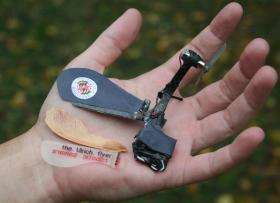Spiraling Flight of Maple Tree Seeds Inspires New Surveillance Technology (w/ Video)

(PhysOrg.com) -- Maple tree seeds (or samara fruit) and the spiraling pattern in which they glide to the ground have delighted children for ages and perplexed engineers for decades. Now aerospace engineering graduate students at the University of Maryland’s Clark School of Engineering have learned how to apply the seeds’ unique design to devices that can hover and perform surveillance in defense and emergency situations.
In the 1950s, researchers first tried to create an unmanned aerial vehicle that could mimic a maple seed's spiraling fall. Ever since, their attempts have been foiled by instability, resulting in a lack of control over the tiny (less than one meter) vehicles, which were easily knocked off course by wind. As recently as June 2009, this was considered as an open challenge for engineers.
Part of the solution to controlling flight was to physically separate the problem of propulsion and stability. The wing of the vehicle is designed to function in the same way as natural samara and performs a stable autorotation during descent. The propulsive section of the vehicle functions like the tail rotor on a helicopter, though instead of preventing rotation, (as in the case of a helicopter), it maintains rotation (to allow it to hover).
The Clark School researchers made use of research and testing techniques developed at the school's Alfred Gessow Rotorcraft Center to develop the maple seed-inspired device. The aerodynamic and geometric properties of natural samara were studied in detail. The insight gleaned from this study enabled the creation of the world's smallest controllable single-winged rotorcraft.
The vehicle has been demonstrated at University of Maryland events, the American Helicopter Society Annual Forum, the Smithsonian Udvar-Hazy Air and Space Museum, and at the 100th anniversary of the College Park airport.

More information: Project Web Site -- www.avl.umd.edu/projects/proj9-robotic-samara.html
Provided by University of Maryland (news : web)




















